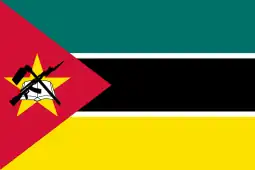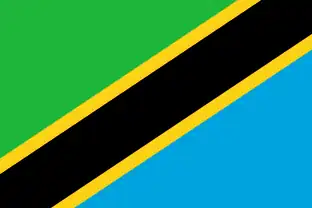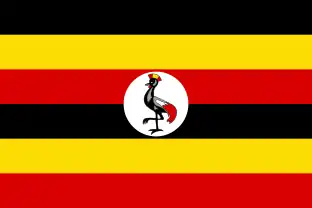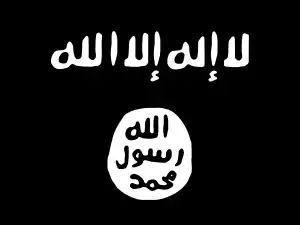130 mm towed field gun M1954 (M-46)
The 130 mm towed field gun M-46 (Russian: 130-мм пушка M-46) is a manually loaded, towed 130 mm artillery piece, manufactured in the Soviet Union in the 1950s. It was first observed by the west in 1954.
| M-46 or KS-30 | |
|---|---|
 M-46 130 mm field gun | |
| Type | Towed field gun |
| Place of origin | Soviet Union |
| Service history | |
| Wars | Vietnam War[1] Eritrean War of Independence South African Border War Six-Day War[2] Yom Kippur War Ethiopian Civil War Angolan Civil War Uganda–Tanzania War Iran–Iraq War First Nagorno-Karabakh War Yugoslav Wars Kosovo War Syrian Civil War Yemeni Civil War (2015–present) Second Nagorno-Karabakh War Tigray War Israeli–Lebanese conflict Russo-Ukrainian War[3] |
| Production history | |
| Designed | 1946–1950 |
| Manufacturer | MOTZ |
| Produced | 1951–1971 |
| Specifications | |
| Mass | 7,700 kg (17,000 lb) |
| Length | 11.73 m (38 ft 6 in) |
| Barrel length | Bore: 7.15 m (23 ft 5 in) L/55 |
| Width | 2.45 m (8 ft) |
| Height | 2.55 m (8 ft 4 in) |
| Crew | 8 |
| Shell | 130 x 845 mm R [4] (R/184.6mm) separate-loading charge and projectile |
| Caliber | 130 mm (5.1 in) |
| Breech | Horizontal sliding-wedge |
| Recoil | hydro-pneumatic |
| Carriage | Split-trail |
| Elevation | −2.5° to 45° |
| Traverse | 50° |
| Rate of fire | 6 rpm (normal) 8 rpm (burst) 5 rpm (sustained) |
| Muzzle velocity | 930 m/s (3,051 ft/s) |
| Maximum firing range | 27 km (17 mi) (unassisted) 40 km (25 mi) (assisted) |
For many years, the M-46 was one of the longest range artillery pieces in existence, with a range of more than 27 km (17 mi) (unassisted) and 40 km (25 mi) (assisted).
Design history
The order was given in April 1946 to design a "duplex" artillery pice to replace the obsolete 122 mm gun M1931/37 (A-19), 152 mm howitzer-gun M1937 (ML-20) and other World War II era field guns, such as 122 mm Model 1931, 152 mm Model 1910/30, 152 mm Model 1935 (BR-2). The new pieces, designed by the factory No 172 (MOTZ), shared the same carriage and were given the designators M-46 (130 mm) and M-47 (152 mm). The respective GRAU designators are 52-P-482 and 52-P-547. The development phase was finished in 1950 and one year later, series production began. Many M-46s were exported.
A second "duplex" artillery system was subsequently designed by FF Petrov's design bureau at Artillery Factory No 9. This comprised a 122 mm gun and a 152 mm howitzer. The D-74 122 mm field gun was a competitor to the M-46; and while many were produced, the M-46 became the only long range gun in Soviet service until new 152 mm guns were made in the 1970s.
Description

The M-46 was developed from the M-36 130 mm naval gun used on ships and for coast defence. It is a true gun, being unable to fire much above 45° and having a long barrel and a single propelling charge. In contrast, most Western field guns of this period had a dual high and low angle fire ability, a gun-howitzer.
It has a 55 calibre barrel with a tied jaw horizontal sliding-block breech and 'pepperpot' muzzle brake. The latter is not notably efficient, but subjective reports suggest that it is quite effective in reducing muzzle flash. The hydro-pneumatic recoil system comprises a buffer below the barrel and a recuperator above the barrel. The long barrel enables a substantial propelling charge by providing more length in which to achieve 'all-burnt' and hence projectile acceleration space and thus achieve its 930 m/s muzzle velocity.
The barrel is mounted on a split-trail carriage, with deep box section trails and foam filled road wheels on the ground when firing and 50° of top traverse. The small shield protects little more than the sights, possible including from the effects of muzzle blast, and some protection from machine gun fire in anti-tank engagements. The gun has long and robust trails to provide stability when firing, a large detachable spade is fitted to the end of each when the gun is brought into action.
Non-reciprocating sights are standard Soviet pattern, designed for one-man laying. Included are a direct fire anti-tank telescope, a panoramic periscopic indirect-fire sight (a dial sight) in a reciprocating mounting, an angle of sight scale, and a range drum engraved with the range (distance) scale, coupled to a mounted elevation levelling bubble. The range drum enables the standard Soviet technique of semi-direct fire when the piece is laid visually on the target and the range set on the range drum. An APN-3 was later provided for direct fire at night in place of the day telescope.
For travel, the gun is towed via a two-wheeled limber fitted to the end of the closed trails, with the spades removed and carried on each trail. Simple jacks on the trails just behind the main wheels are used to lift and support the closed trails so that the limber can be connected. The barrel and recuperator are pulled back between the closed trails and locked in a travelling position. There is a large bicycle chain arrangement on the right trail for this, and a compressed air cylinder, charged by the gun firing, is used to bring the barrel forward when the gun is brought back into action. It takes about four minutes to bring the gun into action, the normal detachment is eight strong.
Propelling charges are in metal cartridge cases and loaded separately from the projectile. Projectiles originally included HE fragmentation, Armour Piercing solid shot, smoke, illuminating and chemical. HE shells weigh ~33 kg (73 lb). Illuminating shells have a substantially lower muzzle velocity. APHE and extended range shells were introduced later. Maximum rate of fire is probably 6-7 rounds/minute, and about 70 rounds/hour. The standard Soviet unit of fire was 80 rounds.[5][6][7]
Operational history
.jpg.webp)
The M-46 was first seen openly at the 1954 May Day Parade in Moscow. It initially replaced the 100 mm BS-3 field and anti-tank gun. However, its long range made it well suited for counter-battery actions. There are reports of poor fragmentation. Its Soviet use with an integrated fire-control system including SNAR-2 radars has also been reported. In Soviet service, M-46 battalions were in Army and Front artillery brigades.
It is or has been in service with at least 25 countries and has been license manufactured in China as the Type 59. It was replaced in Soviet/Russian inventory by the 2A36 Giatsint-B and the self-propelled 2S5 Giatsint-S. Several companies, like Soltam and RDM Technology BV, have presented upgrade packages for the gun. These include, for instance, an upgrade to a 45 caliber 155 mm gun. Its long range made it especially useful in the Vietnam War.[8]
The M-46 saw extensive combat service with the People's Armed Forces for the Liberation of Angola (FAPLA) during the Angolan Civil War and South African Border War.[9] From the mid to late 1970s Angolan M-46s were deployed with some success in the counter-battery role against South African artillery units, which possessed comparatively short-ranged BL 5.5-inch medium guns.[10] South Africa later acquired six M-46s from Israel for evaluation purposes; this likely influenced its development of the G5 howitzer, which was adopted to counter the range and effectiveness of the FAPLA field guns.[11] Cuba also deployed M-46 batteries of its own in support of FAPLA operations during its lengthy military intervention in Angola.[12] Cuban and FAPLA M-46s were used most notably during the Battle of Cuito Cuanavale, where individual guns were deployed in ones or twos rather than concentrated in single positions to reduce the threat posed by counter-battery fire from South African G5s.[13] Cuban tacticians were able to repeatedly stall a South African mechanized and armored offensive by using minefields to channel the attackers into bottlenecks where the M-46s could concentrate their fire.[13]
Tanzania People's Defence Force fielded some M-46 guns during Uganda–Tanzania War in 1978–1979.[14]
A version of this gun, possibly the Chinese-manufactured Type 59–1, is suspected to have been used by North Korea for shelling the South Korean island of Yeonpyeong in the Yellow Sea on 23 November 2010.
Variants
Soviet Union
- M-47 – This is a 152 mm field gun (Russian: 152-мм пушка M-47 обр. 1953 г.) that was developed alongside the M-46. The M-47 had a range of 20,470 m and was far less successful than its 130 mm counterpart. Only a small number was built between 1954 and 1957. Externally, the M-46 and M-47 are virtually identical, except for the calibre.
China

- Type 59 – This is a licensed version of the M-46.[15]
- Type 59-1 – This is a combination of the 130 mm ordnance of the Type 59 with the carriage of the Type 60 (D-74 copy). The result is a gun with the same range as the M-46, but with a much lower weight of 6.3 t. The M59-1M is the Egyptian licence version. For the export market, a version with APU and redesigned carriage was developed. Also for the export market, a self-propelled variant, based on the Type 83 SPH was designed.[16]
- Type GM-45 – For the export market, NORINCO (China North Industries Corporation) developed this upgrade package where the original barrel of the Type 59 is replaced by the 155/45 mm ordnance of the WA 021. The Type GM-45 has a maximum range of 39 km when ERFB-BB ammunition is used.[15]
Cuba
- The Cuban army operates two different, locally designed self-propelled versions of the M-46. One is based on the tracked chassis of the T-34-85 tank, while the other is based on a heavily modified KrAZ 6x6 truck. These and other modifications were shown for the first time during the 2006 military parade.
Egypt
- The Egyptian Army operates a locally assembled variant of the M-46[17]
India
- The Indian Army has a total of around 1000 of the 130 mm towed guns that were acquired from the former Soviet Union starting in 1968.[18]
- Upgunned Soltam 155 mm guns – A total of 180 of the 130 mm guns held by Indian Army were upgunned to 155 calibre by the Israeli firm Soltam in 2008.[18]
- IOB Sharang 155 mm/45 calibre guns – Another 155 mm upgrade (45 Calibre) upgrade of the 300 M-46 towed guns, this one designed by Ordnance Factory Board (OFB). The upgraded M-46 has a range of 39 km.[19] India's Ministry of Defence (MoD) has awarded an INR2 billion (US$27.2 million) contract on 25 October 2018 to the state-owned Ordnance Factory Board (OFB) to upgrade 300 of the Indian Army's (IA's) Soviet-era 130 mm/52 calibre M-46 field guns to 155 mm/45 calibre in a bid to augment its firepower.[20]
- SP-130 "Catapult" – Indian-designed self-propelled version, mounted on the hull of the Vijayanta tank.[15]
Israel
- M-46S – This is an upgrade of an existing M-46 or Type 59, carried out by Soltam Systems Ltd. The original barrel is replaced by a new model of 155/45mm (western ammunition) for a range of 25.8 (HE) to 39 km (ERFB-BB). A 39-calibre barrel is optional. In March 2000, Soltam won a contract worth $47,524,137 for upgrading 180 M-46s to M-46S standard (Indian designator: 155/45mm (E1) Soltam). A follow-on deal for 250 retrofit kits was optioned for. In 2005, after only 40 howitzers were modified, the M-46S programme was terminated due to a fatal barrel explosion.[15]
Democratic People's Republic of Korea
The US Defense Intelligence Agency has reported the existence of a number of locally designed self-propelled artillery systems, including the SPG 130 mm M1975, the SPG 130 mm M1981 and the SPG 130 mm M1991. Details are not available, but they appear to be M-46/Type 59s mounted on a tracked chassis “Tokchon”.[15]
Serbia
- M46/84 – This is a conversion that involved replacing the original 130 mm barrel with a new 155/45 mm barrel or 152 mm barrel. With ERFB-BB ammunition, this version has a range of 38,600 m and with M05 152 mm range exceeds 40 km.[16]
Netherlands
- RDM Technology BV is yet another company that offers an upgrade of the M-46/Type 59 that involves fitting a new 155mm/45 barrel.[15]
Romania
- A412 – License-built Chinese Type 59–1 with D-20 carriage.[21] In Romanian Army service, the A412 is known as the 130 mm towed gun M1982 (Romanian: Tun calibrul 130-mm tractat M1982). The A412 was also exported.[15]
Type 59-1 was manufactured by Arsenal Resita under the designation A412 Model 1982 between 1982 and 1989. A maximum range of 33 km (21 mi) was reached Using NORINCO's Base Bleed ammunition. The A412 cannon can fire a 7-8 rounds per minute. The A412 was exported to four other countries: Bosnia-Herzegovina, Cameroon, Guinea, and Nigeria.
Projectiles
- Frag-HE, 3OF33 (with full charge 3VOF43) – range: 27,490 meters
- Frag-HE, 3OF33 (with separate charge 3VOF44) – range: 22,490 meters
- Frag-HE, ERFB-BB – Extended Range Full Bore – Base Bleed, range: 38,000 meters
- APCBC-HE-T, BR-482 and BR-482B – range: 1,140 meters
- Guided Shell, Firn-1 – range: 24,000 meters
- Smoke
- Chemical
- Illumination
Operators


 Algeria: 10[23]: 340
Algeria: 10[23]: 340  Angola: 146 acquired from the Soviet Union and Bulgaria;[24] 48 in service[23]: 460
Angola: 146 acquired from the Soviet Union and Bulgaria;[24] 48 in service[23]: 460  Azerbaijan: 36 acquired from Bulgaria.[25]
Azerbaijan: 36 acquired from Bulgaria.[25] Bangladesh: 62; Type 59-1 variant[23]: 254
Bangladesh: 62; Type 59-1 variant[23]: 254  Bosnia-Herzegovina: 8; A412 variant[24]
Bosnia-Herzegovina: 8; A412 variant[24] Cambodia: Type 59-1s[24]
Cambodia: Type 59-1s[24] Cameroon: 12 A412 variant[24] and 12 Type 59 variant[26]
Cameroon: 12 A412 variant[24] and 12 Type 59 variant[26] People's Republic of China: 234 in service in 2016; Type 59 and Type 59-1 variants[23]: 261
People's Republic of China: 234 in service in 2016; Type 59 and Type 59-1 variants[23]: 261  Republic of the Congo: 5[23]: 470
Republic of the Congo: 5[23]: 470  Democratic Republic of the Congo: 42; Type 59 and Type-59-1 variants[23]: 472
Democratic Republic of the Congo: 42; Type 59 and Type-59-1 variants[23]: 472  Cuba: 197[24]
Cuba: 197[24] Egypt: 650; 250 M-46 and 400 Type 59-1M[24]
Egypt: 650; 250 M-46 and 400 Type 59-1M[24] Eritrea: 39 acquired from Bulgaria[24] 19 in service.[27]
Eritrea: 39 acquired from Bulgaria[24] 19 in service.[27] Ethiopia: 114[24]
Ethiopia: 114[24]
 Guinea: 12; A412 variant[24]
Guinea: 12; A412 variant[24] Guyana: 6, IISS questions their serviceability as of 2020[23]: 434
Guyana: 6, IISS questions their serviceability as of 2020[23]: 434  India: ~600 in service and ~500 in store; 200 modified to 155 mm caliber[23]: 271
India: ~600 in service and ~500 in store; 200 modified to 155 mm caliber[23]: 271  Iran: 726; 100 M-46 and 626 Type 59;[24] another estimate gives 985 M-46s[23]: 349
Iran: 726; 100 M-46 and 626 Type 59;[24] another estimate gives 985 M-46s[23]: 349  Iraq: 676;[24] M-46 and Type 59 variants.[23]: 353
Iraq: 676;[24] M-46 and Type 59 variants.[23]: 353  Israel:[23]: 345 Captured from Syria and Egypt.[11]
Israel:[23]: 345 Captured from Syria and Egypt.[11] Laos: 10[23]: 291
Laos: 10[23]: 291  Lebanon: 15[23]: 362 -16[24]
Lebanon: 15[23]: 362 -16[24] Libya: 330[24]
Libya: 330[24] Mongolia: 50[24]
Mongolia: 50[24] Morocco: 18 Donated by Egypt in the late 1970s[23]: 367
Morocco: 18 Donated by Egypt in the late 1970s[23]: 367  Mozambique: 24[24] 6 in service in 2016.[23]: 490
Mozambique: 24[24] 6 in service in 2016.[23]: 490  Myanmar: 16 Type 59-1 and 160 M-46 in service[29]
Myanmar: 16 Type 59-1 and 160 M-46 in service[29] Nigeria: 4; A412 variant;[24] another estimate gives 7 M-46s[23]: 494
Nigeria: 4; A412 variant;[24] another estimate gives 7 M-46s[23]: 494  North Korea: 210; 160 M-46 and 50 Type 59[24]
North Korea: 210; 160 M-46 and 50 Type 59[24] Oman: 15 acquired from unidentified source.[24] Other source gives 12 M-46s and 12 Type 59-1s.[23]: 369
Oman: 15 acquired from unidentified source.[24] Other source gives 12 M-46s and 12 Type 59-1s.[23]: 369  Pakistan: 360; 100 M-46 and 260 Type 59;[24][30] another estimate gives 410 Type 59-1s in service in 2016[23]: 300
Pakistan: 360; 100 M-46 and 260 Type 59;[24][30] another estimate gives 410 Type 59-1s in service in 2016[23]: 300  Peru: 30[24] to 36[23]: 433
Peru: 30[24] to 36[23]: 433  Romania: 75; A412 variant[31]
Romania: 75; A412 variant[31] Russia: 650[23]: 196
Russia: 650[23]: 196  Serbia:[32] 36[23]: 141
Serbia:[32] 36[23]: 141  South Sudan[23]: 502
South Sudan[23]: 502  Sri Lanka: 12[24] to 30;[23]: 310 Type 59 or Type 59-1 variant[24]
Sri Lanka: 12[24] to 30;[23]: 310 Type 59 or Type 59-1 variant[24] Sudan: 30[24] to 75;[23]: 503 Type 59 variant[24]
Sudan: 30[24] to 75;[23]: 503 Type 59 variant[24] Syria: 650[24]
Syria: 650[24]
 Tanzania: 30[23]: 506 to 50;[24] Type 59-1 variant[23]: 506
Tanzania: 30[23]: 506 to 50;[24] Type 59-1 variant[23]: 506  Thailand: 54; Type 59 variant[24]
Thailand: 54; Type 59 variant[24] Uganda: 6 acquired from Bulgaria.[25]
Uganda: 6 acquired from Bulgaria.[25] Ukraine: 24 (M-46H1 variant) provided by Croatia in 2022.[34][35][36] An unknown number also provided by Finland.[37]
Ukraine: 24 (M-46H1 variant) provided by Croatia in 2022.[34][35][36] An unknown number also provided by Finland.[37] United Arab Emirates: 20; Type 59-1 variant[23]: 381
United Arab Emirates: 20; Type 59-1 variant[23]: 381  Vietnam: 519[24]
Vietnam: 519[24] Zambia: 18; Type 59 variant[24]
Zambia: 18; Type 59 variant[24]
Former operators

 Soviet Union
Soviet Union.svg.png.webp) Afghanistan: 428[24]
Afghanistan: 428[24].svg.png.webp) People's Socialist Republic of Albania: 100; Type 59 variant[24]
People's Socialist Republic of Albania: 100; Type 59 variant[24].svg.png.webp) People's Republic of Bulgaria: 72[24]
People's Republic of Bulgaria: 72[24] Croatia: 36; M-46H1 variant[38]
Croatia: 36; M-46H1 variant[38] East Germany: 175[24]
East Germany: 175[24] Finland: 144 acquired from the Soviet Union in 1965-66 and 166 from ex-East-Germany in 1993;[24] in 2016, 36 were still in service under designation 130 K 54, all withdrawn from active service in 2019
Finland: 144 acquired from the Soviet Union in 1965-66 and 166 from ex-East-Germany in 1993;[24] in 2016, 36 were still in service under designation 130 K 54, all withdrawn from active service in 2019 Germany: Former East German guns; 166 sold to Finland in 1993
Germany: Former East German guns; 166 sold to Finland in 1993 Islamic State: 34[39][40]
Islamic State: 34[39][40]- Liberation Tigers of Tamil Eelam: 12; Type 59-1[41]
 Palestine Liberation Organization: 10 acquired from East Germany[24]
Palestine Liberation Organization: 10 acquired from East Germany[24] People's Republic of Kampuchea: 30[24]
People's Republic of Kampuchea: 30[24] Somalia: 10; Type 59 variant[24]
Somalia: 10; Type 59 variant[24].svg.png.webp) South Africa: 6 on loan from Israel, later returned[11]
South Africa: 6 on loan from Israel, later returned[11]- South Lebanon Army: 5 acquired from Israel[24]
 Yemen: 93 received;[24] ~60 in service in 2016[42]
Yemen: 93 received;[24] ~60 in service in 2016[42].svg.png.webp) Yugoslavia: 186[24]
Yugoslavia: 186[24]
See also
References
- Tucker, Spencer C., ed. (May 2011). The Encyclopedia of the Vietnam War: A Political, Social, and Military History (2 ed.). p. 1251. ISBN 978-1-85109-960-3.
- Dunstan, Simon (10 November 2009). The Six Day War 1967: Jordan and Syria. Campaign 212. Osprey Publishing. p. 65. ISBN 978-1-84603-364-3.
- David Axe (27 October 2022). "Ukraine Is Collecting A Lot Of Russia's Old T-62 Tanks". Forbes.
- ordnanceandmilitaria.com/110-to-149mm-ammo
- Red God of War – Soviet Artillery and Rocket Forces, Chris Bellamy, Brasseys, 1986. ISBN 0-08-031200-4
- Artillery of the World, ed. Shelford Bidwell, Brasseys, 1977. ISBN 0-904609-04-9
- The Encyclopedia of World Military Weapons 1988. ISBN 0-517-65341-9
- "M-46 130 mm Field Gun". Military-Today.com. Retrieved 20 March 2021.
- Vanneman, Peter (1990). Soviet Strategy in Southern Africa: Gorbachev's Pragmatic Approach. Stanford: Hoover Institution Press. pp. 41–51. ISBN 978-0-8179-8902-6.
- Harmse, Kyle; Dunstan, Simon (23 February 2017). South African Armour of the Border War 1975–89. Oxford: Osprey Publishing. pp. 31–38. ISBN 978-1-4728-1743-3.
- Leon Engelbrecht (10 February 2011). "G6 L45 self-propelled towed gun-howitzer". Archived from the original on 9 January 2014. Retrieved 13 November 2014.
- George, Edward (2005). The Cuban intervention in Angola. New York: Frank Cass Publishers. p. 226. ISBN 978-0-415-64710-6.
- Bridgland, Fred (1990). The War for Africa: Twelve months that transformed a continent. Gibraltar: Ashanti Publishing. pp. 300–327. ISBN 978-1-874800-12-5.
- Cooper, Tom; Fontanellaz, Adrien (October 2016). "La guerre du Kagera". Batailles et Blindés (in French). No. 75. Caraktère. pp. 72–81. ISSN 1765-0828.
- Janes Armour and Artillery 2003–2004
- Janes Armour and Artillery 1993–1994 ISBN 0-7106-1074-2
- "Egypt :: Abou Zaabal Co. For Engineering Industries .::. ابو زعبل للصناعات الهندسية :: تفاصيل المنتجات الحربيه". Archived from the original on 25 April 2012. Retrieved 22 August 2018.
- "Defence Ministry signs Rs 200 crore contract to upgun 130 mm howitzers". India Today. Retrieved 18 October 2018.
- "Ordnance Factory Board". Archived from the original on 19 November 2014. Retrieved 13 November 2014.
- "India's OFB wins tender to upgrade 300 M-46 field guns". Archived from the original on 3 November 2018. Retrieved 3 November 2018.
- Stroea, Adrian; Băjenaru, Gheorghe (2010) – Artileria română în date și imagini – Editura Centrului Tehnic-Editorial al Armatei - ISBN 978-606-524-080-3
- QPVN. "Học viện Kỹ thuật Quân sự - Thời cơ và khát vọng". www.qpvn.vn (in Vietnamese). Retrieved 27 October 2021.
- International Institute for Strategic Studies (2020). The Military Balance. Vol. 120. Routledge. pp. 141–506. ISBN 978-0-367-46639-8.
- "Trade Registers". Armstrade.sipri.org. Archived from the original on 14 April 2010. Retrieved 20 November 2014.
- "United Nations Register of Conventional Arms: Report of the Secretary-General" (PDF). New York: United Nations. 21 August 2003. Archived from the original (PDF) on 12 September 2017. Retrieved 12 September 2017.
- The Military Balance 2021, p. 454.
- The Military Balance 2021, p. 464.
- Mitzer, Stijn; Oliemans, Joost (1 September 2021). "The Tigray Defence Forces - Documenting Its Heavy Weaponry". Oryx Blog.
- "SIPRI Trade Register". Stockholm International Peace Research Institute.
- Pike, John. "Pakistan Army Equipment". Globalsecurity.org. Archived from the original on 26 October 2012. Retrieved 19 March 2013.
- "United Nations Official Document". Archived from the original on 9 July 2014. Retrieved 20 November 2016.
- "M-46 130 mm Gun, Serbian Armed Forces (Serbian)". Archived from the original on 19 November 2014. Retrieved 13 November 2014.
- "Syrie: rudes combats à Abou Dali entre les djihadistes d'Hayat Tahrir al-Cham et le régime de Damas". France Soir (in French). 19 October 2017. Archived from the original on 29 June 2018. Retrieved 28 June 2018.
- "Government of the Republic of Croatia - Croatia sending emergency aid to Ukraine". vlada.gov.hr. Retrieved 9 April 2023.
- "Croatia donates M-46 field guns to Ukraine | Shephard". www.shephardmedia.com. Retrieved 9 April 2023.
- "Croatia donates M-46 field guns to Ukraine". shephardmedia.com. 15 August 2022. Retrieved 19 September 2022.
- "Chapter Four: Europe". The Military Balance. International Institute for Strategic Studies. 119 (1): 95. 2019. doi:10.1080/04597222.2018.1561029. S2CID 219622746.
- "Vehicles and equipment captured and operated by the Islamic State inside Syria". spioenkop.blogspot.com. 10 November 2014. Archived from the original on 12 November 2014. Retrieved 25 March 2019.
- "Etat islamique et chars d'assaut: comment les djihadistes emploient leurs blindés en Irak et en Syrie". France Soir (in French). 2 February 2017. Archived from the original on 3 February 2017. Retrieved 27 February 2019.
- Humanitarian Operation Factual Analysis July 2006 – May 2009 (PDF). Ministry Of Defence Democratic Socialist Republic Of Sri Lanka. Retrieved 9 September 2021.
- "Chapter Seven: Middle East and North Africa". The Military Balance. International Institute for Strategic Studies. 116 (1): 358. 2015. doi:10.1080/04597222.2015.996362. S2CID 219625386.
- International Institute for Strategic Studies (February 2021). The Military Balance 2021. Vol. 121. Routledge. ISBN 9781032012278.
External links
- M-46
- Type 59 130mm towed gun
- 130 K 54 RT Finnish 130 K 154 Training